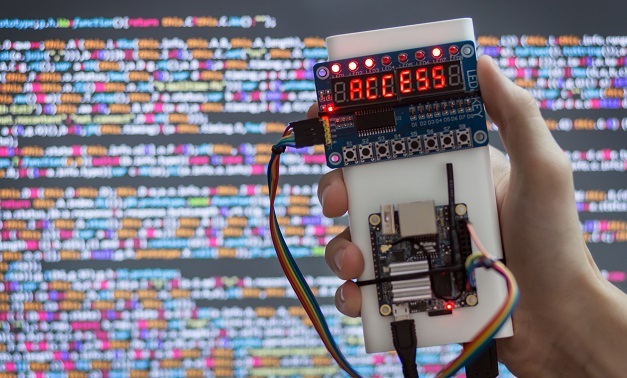
- Trending Categories
 Data Structure
Data Structure Networking
Networking RDBMS
RDBMS Operating System
Operating System Java
Java MS Excel
MS Excel iOS
iOS HTML
HTML CSS
CSS Android
Android Python
Python C Programming
C Programming C++
C++ C#
C# MongoDB
MongoDB MySQL
MySQL Javascript
Javascript PHP
PHPPhysics
Chemistry
Biology
Mathematics
English
Economics
Psychology
Social Studies
Fashion Studies
Legal Studies
- Selected Reading
- UPSC IAS Exams Notes
- Developer's Best Practices
- Questions and Answers
- Effective Resume Writing
- HR Interview Questions
- Computer Glossary
- Who is Who
What is the full form of DAO?
Introduction to DAO
Data Access Objects (DAO) is a design pattern commonly used in software development to abstract the underlying data storage mechanism from the business logic and provide a consistent interface for accessing data in a database or other data storage systems. DAO acts as an intermediary between the application's business logic and the data storage system, providing a set of well-defined methods and interfaces to perform common data operations, such as creating, retrieving, updating, and deleting data.

DAOs encapsulate the details of how data is stored and retrieved, allowing the rest of the application to work with a consistent interface regardless of the underlying data storage technology being used.
Importance of DAO in software development
Data Access Objects (DAO) is an important concept in software development for several reasons −
Abstraction of data storage technology − DAO allows developers to abstract the details of how data is stored and retrieved from the underlying data storage technology, such as a database or API.
Separation of concerns − DAO promotes separation of concerns by isolating the data access logic from the business logic of an application.
Code reusability − DAO provides a set of reusable methods and interfaces for performing common data operations, such as CRUD (Create, Retrieve, Update, Delete) operations.
Testability − DAOs can be easily mocked or stubbed during unit testing, allowing for effective testing of the application's business logic without the need to interact with actual data storage systems.
Security − DAO can be used to implement security measures, such as access control and data validation, at the data access layer.
Scalability and maintainability − By abstracting the data access logic and providing a consistent interface, DAO makes it easier to scale and maintain an application.
Examples of DAO implementation in different programming languages
Data Access Objects (DAO) can be implemented in various programming languages, depending on the technology stack being used. Here are some examples of DAO implementation in different programming languages −
Java − In Java, DAO can be implemented using Java Database Connectivity (JDBC) API, which provides a standard way to interact with relational databases. DAO can be implemented as Java interfaces or classes, with methods for common data operations such as insert, select, update, and delete.
Python − In Python, DAO can be implemented using libraries such as SQLAlchemy or Django ORM, which provide Object-Relational Mapping (ORM) for database operations. ORM allows developers to work with databases using Python objects and classes, abstracting the underlying SQL queries.

C# − In C#, DAO can be implemented using ADO.NET, which is a data access technology provided by Microsoft for interacting with databases. ADO.NET provides classes and interfaces for performing data operations using SQL queries or stored procedures.
Advantages and disadvantages of using DAO in database applications
Data Access Objects (DAO) have several advantages and disadvantages in the context of database applications −
Advantages of using DAO
Separation of Concerns − DAO helps to separate the database logic from the business logic of an application which makes the codebase more maintainable, scalable, and easier to understand, as changes in the database logic can be isolated to the DAO layer without impacting the rest of the application.
Code Reusability − DAO promotes code reusability, as the database operations are encapsulated in DAO methods. This allows developers to reuse DAO methods across different parts of the application or even in different applications, reducing duplication of code and improving development efficiency.
Abstraction of Database Operations − DAO provides a higher level of abstraction for interacting with databases, allowing developers to work with objects and classes instead of raw SQL queries which makes it easier to switch to a different database system or make changes to the database schema without affecting the rest of the application code.
Testability − DAO makes it easier to write unit tests for database-related functionality, as the DAO methods can be mocked or stubbed to isolate the database interactions during testing. This allows for thorough testing of the application's data access layer, ensuring robustness and reliability of the database operations.
Disadvantages of using DAO
Additional Abstraction Layer − DAO adds an additional abstraction layer to the application architecture, which may introduce some overhead in terms of development time and performance.
Learning Curve − DAO requires developers to learn and understand the additional concepts and patterns associated with it, such as interfaces, implementations, and mapping between objects and databases.
Increased Complexity − DAO may introduce additional complexity in the application codebase, as it requires additional classes, interfaces, and methods to be implemented for data access operations.
Performance Considerations − Depending on the implementation and usage, DAO may introduce some performance considerations, such as additional overhead for object-relational mapping (ORM) or database connection management. However, these can often be mitigated through proper design and optimization techniques.
FAQs
Q1. What are Data Access Objects?
Ans. Data Access Objects (DAOs) are a design pattern used in software development that separates the application's data access logic from its business logic. DAOs provide an abstraction layer that allows the application to interact with data sources, such as databases or APIs, in a modular and organised manner.
Q2. Why is DAO important in the present world?
Ans. DAOs are important in the present world as they represent a paradigm shift towards decentralised, transparent, and autonomous forms of organisation, with potential benefits in various domains, including governance, economics, innovation, and inclusivity.
Q3. What are the benefits of DAO?
Ans. DAOs can provide several benefits in terms of abstraction, code reusability, separation of concerns, improved testability, security, and maintainability, making them a useful pattern for handling data access in software applications.

